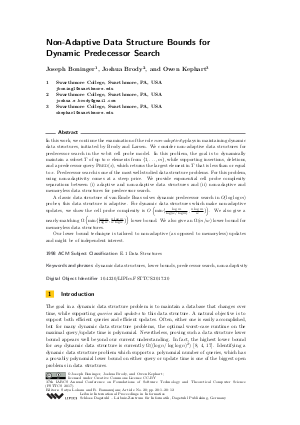Non-Adaptive Data Structure Bounds for Dynamic Predecessor
Authors Joseph Boninger, Joshua Brody, Owen Kephart
-
Part of:
Volume:
37th IARCS Annual Conference on Foundations of Software Technology and Theoretical Computer Science (FSTTCS 2017)
Part of: Series: Leibniz International Proceedings in Informatics (LIPIcs)
Part of: Conference: IARCS Annual Conference on Foundations of Software Technology and Theoretical Computer Science (FSTTCS) - License:
 Creative Commons Attribution 3.0 Unported license
Creative Commons Attribution 3.0 Unported license
- Publication Date: 2018-02-12
File

PDF
LIPIcs.FSTTCS.2017.20.pdf
- Filesize: 488 kB
- 12 pages
Document Identifiers
Subject Classification
Keywords
- dynamic data structures
- lower bounds
- predecessor search
- non-adaptivity
Metrics
- Access Statistics
-
Total Accesses (updated on a weekly basis)
0Document
0Metadata
Abstract
In this work, we continue the examination of the role non-adaptivity plays in maintaining dynamic data structures, initiated by Brody and Larsen. We consider non-adaptive data structures for predecessor search in the w-bit cell probe model. In this problem, the goal is to dynamically maintain a subset T of up to n elements from
{1, ..., m}, while supporting insertions, deletions, and a predecessor query Pred(x), which returns the largest element in T that is less than or equal to x. Predecessor search is one of the most well-studied data structure problems. For this problem, using non-adaptivity comes at a steep price. We provide exponential cell probe complexity separations between (i) adaptive and non-adaptive data structures and (ii) non-adaptive and memoryless data structures for predecessor search.
A classic data structure of van Emde Boas solves dynamic predecessor search in log(log(m)) probes; this data structure is adaptive. For dynamic data structures which make non-adaptive updates, we show the cell probe complexity is O(log(m)/log(w/log(m))). We also give a nearly-matching Omega(log(m)/log(w)) lower bound. We also give an m/w lower bound for memoryless data structures.
Our lower bound technique is tailored to non-adaptive (as opposed to memoryless) updates and might be of independent interest.
Cite As Get BibTex
Joseph Boninger, Joshua Brody, and Owen Kephart. Non-Adaptive Data Structure Bounds for Dynamic Predecessor. In 37th IARCS Annual Conference on Foundations of Software Technology and Theoretical Computer Science (FSTTCS 2017). Leibniz International Proceedings in Informatics (LIPIcs), Volume 93, pp. 20:1-20:12, Schloss Dagstuhl – Leibniz-Zentrum für Informatik (2018)
https://doi.org/10.4230/LIPIcs.FSTTCS.2017.20
BibTex
@InProceedings{boninger_et_al:LIPIcs.FSTTCS.2017.20,
author = {Boninger, Joseph and Brody, Joshua and Kephart, Owen},
title = {{Non-Adaptive Data Structure Bounds for Dynamic Predecessor}},
booktitle = {37th IARCS Annual Conference on Foundations of Software Technology and Theoretical Computer Science (FSTTCS 2017)},
pages = {20:1--20:12},
series = {Leibniz International Proceedings in Informatics (LIPIcs)},
ISBN = {978-3-95977-055-2},
ISSN = {1868-8969},
year = {2018},
volume = {93},
editor = {Lokam, Satya and Ramanujam, R.},
publisher = {Schloss Dagstuhl -- Leibniz-Zentrum f{\"u}r Informatik},
address = {Dagstuhl, Germany},
URL = {https://drops.dagstuhl.de/entities/document/10.4230/LIPIcs.FSTTCS.2017.20},
URN = {urn:nbn:de:0030-drops-83892},
doi = {10.4230/LIPIcs.FSTTCS.2017.20},
annote = {Keywords: dynamic data structures, lower bounds, predecessor search, non-adaptivity}
}
Author Details
References
-
Alok Aggarwal, Jeffrey Vitter, et al. The input/output complexity of sorting and related problems. Communications of the ACM, 31(9):1116-1127, 1988.

- Joshua Brody and Kasper Green Larsen. Adapt or die: Polynomial lower bounds for non-adaptive dynamic data structures. Theory of Computing, 11:471-489, 2015. URL: http://dx.doi.org/10.4086/toc.2015.v011a019.
-
Arkadev Chattopadhyay, Jeff Edmonds, Faith Ellen, and Toniann Pitassi. Upper and lower bounds on the power of advice. SIAM Journal on Computing, 45(4):1412-1432, 2016.

-
Raphael Clifford, Allan Grønlund, and Kasper Green Larsen. New unconditional hardness results for dynamic and online problems. In Proc. 56th Annual IEEE Symposium on Foundations of Computer Science (FOCS), pages 1089-1107. IEEE, 2015.

-
Michael Fredman and Michael Saks. The cell probe complexity of dynamic data structures. In Proc. 21st ACM ACM Symposium on Theory of Computing (STOC), pages 345-354. ACM, 1989.

-
Fabian Kuhn, Nancy Lynch, and Rotem Oshman. Distributed computation in dynamic networks. In Proceedings of the forty-second ACM symposium on Theory of computing, pages 513-522. ACM, 2010.

-
Fabian Kuhn and Rotem Oshman. Dynamic networks: models and algorithms. ACM SIGACT News, 42(1):82-96, 2011.

-
Kasper Green Larsen. The cell probe complexity of dynamic range counting. In Proc. 44th ACM Symposium on Theory of Computing (STOC), pages 85-94, 2012.

-
Mihai Pǎtraşcu. Towards polynomial lower bounds for dynamic problems. In Proc. 42nd ACM Symposium on Theory of Computing (STOC), pages 603-610, 2010.

-
Mihai Pǎtraşcu and Mikkel Thorup. Time-space trade-offs for predecessor search. In Proc. 38th ACM Symposium on Theory of Computing (STOC), pages 232-240, 2006.

-
Mihai Pǎtraşcu and Mikkel Thorup. Randomization does not help searching predecessors. In Proc. 18th ACM/SIAM Symposium on Discrete Algorithms (SODA), pages 555-564, 2007.

-
Sivaramakrishnan Natarajan Ramamoorthy and Anup Rao. Non-adaptive data structure lower bounds for median and predecessor search from sunflowers. https://eccc.weizmann.ac.il/report 040/, 2017.

-
Nir Shavit. Data structures in the multicore age. Communications of the ACM, 54(3):76-84, 2011.

-
Peter van Emde Boas. Preserving order in a forest in less than logarithmic time. In Proc. 16th Annual IEEE Symposium on Foundations of Computer Science (FOCS), pages 75-84, 1975.

-
Elad Verbin and Qin Zhang. The limits of buffering: a tight lower bound for dynamic membership in the external memory model. SIAM Journal on Computing, 42(1):212-229, 2013.

-
Jeffrey Scott Vitter. External memory algorithms and data structures: Dealing with massive data. ACM Computing surveys (CsUR), 33(2):209-271, 2001.

-
Omri Weinstein and Huacheng Yu. Amortized dynamic cell-probe lower bounds from four-party communication. In Foundations of Computer Science (FOCS), 2016 IEEE 57th Annual Symposium on, pages 305-314. IEEE, 2016.

-
Andrew Chi-Chih Yao. Should tables be sorted? Journal of the ACM (JACM), 28(3):615-628, 1981.

